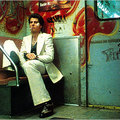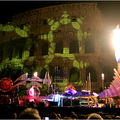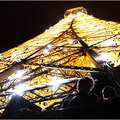
The view from the Sky Suite, available to visitors.
I'D stopped to use the bathroom at the McDonald's three miles from Arcosanti, the famously never-finished experimental city in the Arizona desert. This is cactus country, an arid hour north of Phoenix, and the McDonald's and Arcosanti were the most prominent outposts of civilization for miles. I asked the woman at the register what she'd heard of the place.
“Very bad, very bad. The people there ...” she trailed off, searching for a word that might capture the terribleness. “I've heard it's a cult.”
Sold.
To emerge from the massive, improbable strip mall that is Phoenix, after all, is to suspect the species needs a new plan, and soon. Sprawl stretches interminably. Sustainable growth, as an issue, suddenly feels palpable; you're parched and not seeing a lot of water around. The radio admonishes bored teenagers against using meth.
To finally crunch over the three-mile dirt road near Cordes Junction and arrive at this dusty alternative — well, it's a breath of hot, desert air.
At first approach, the skyline — a pair of concrete apses, a network of modular concrete dwellings, a rusty old crane — fails to make much of an impact. But it swells with the dream behind it. The Italian architect Paolo Soleri, a former student of Frank Lloyd Wright, began construction of this ecologically harmonious community in 1970.
With its radical conservation techniques and a brilliantly scrunched-together layout, Arcosanti was intended to reinvent not just the city, but also man's relationship to the planet: picture a 60s vision of a Mars colony, but with a cutting-edge, eco-friendly design. Evaporative cooling pools release moisture into the air. In winter, heat from the foundry furnace is collected by a hood and sent through the apartments above.
And there are always apartments above, or a library below, or another set of rooms just beyond those Italian cypresses. Through a carefully managed density, the impact is minimal, and the idea of community is reimagined.
In 1976, Newsweek declared: “As urban architecture, Arcosanti is probably the most important experiment undertaken in our lifetime.” “Undertaken” being the key word — then and now. Completion has legendarily eluded Arcosanti. Built in stages and chronically underfinanced, the place exists in a permanent state of half-doneness.
What was once the future of intelligently designed communities has morphed into something less optimistic: a stalled revolution in urban planning or a moldering relic of impractical idealism, depending on whom you ask. Often enough it's referred to as Mr. Soleri's “desert utopia,” and as with all utopias, reality doesn't always match the blueprints.
And yet.
The place hums with purpose. An educated, diversely aged and surprisingly international collection of residents rises early each morning for on-site duties: silt casting, or foundry work, or a general tending of the odd, gray structures they call home.
Later, the focus turns to capoeira practice or evening strolls along the canyon ridge. A cozy, dormitory-in-summer feel suffuses the place — if you were to set the college on broil then take away the college part. Shared living spaces. Shared tasks. Even a shared music room.
Conceivably you could let the word “commune” slip over a delicious resident-prepared lunch of roasted yams and bell peppers. Bite your tongue.
“This isn't about divided labor, or shared space or living with your friends — although that all happens here,” a visiting seminar student told me when I was there last spring. “Everyone who comes is here to make arcology work.”
Yes, Mr. Soleri doesn't just imagine cities — he invents words, too. “Arcology,” the portmanteau of architecture and ecology, guides Arcosanti as well as other, generally unrealized, Soleri creations. The pinnacle of arcology, the Hyper-Building, exists only on paper: a kilometer-high tower that would house 100,000 residents plus all their commercial and cultural requirements.
There are not 100,000 people at Arcosanti. The plan was, and is, to draw 5,000; the population is under 100.
To visit Arcosanti now is to catch it at an odd moment. The principles put into practice there long ago — environmental sensitivity, anticonsumerism — have started making their way into general consciousness. As its founder predicted decades ago, the outside world is finally discovering its current course to be unsustainable. Interestingly, for vastly different reasons, Arcosanti finds itself discovering the same.
At a community meeting while I was there, Mr. Soleri, who lives near Phoenix but spends a night or two a week at Arcosanti, eased into an old couch and quietly asked how his creation was going to keep the lights on. While tourism and the sale of bronze and ceramic bells bring in some money, he said, another $50 million would come in especially handy. Residents batted around money-raising strategies that wouldn't sell out Arcosanti's core identity; few stuck.
“Of course, we're sitting on a billion-dollar view,” one woman said, glancing toward the canyon, with its dramatic basalt cliffs and picturesque scatterings of scrub brush. But the idea of selling off a chunk of the dream only drew laughs. Somebody mumbled something about “Disney Arcosanti” and soon conversation moved on.
This is not Disney, or the Plaza, or even Motel 6. Mr. Soleri has defined his creation as “the city in the image of man,” and it forces a certain question where visitors are concerned: Which man, exactly? Certainly not the type who needs to lock his doors, or have his bathroom trash can lined with something finer than a grocery bag. Wheelchair access is limited, and guests are encouraged to bring flashlights.
But the redefining of comfort becomes contagious. And short of, say, financing it for the next century, the best way to appreciate the Arcosanti experiment is to walk it: Here, the site of a future “energy apron” around the perimeter, wherein greenhouses trap heat and disperse it throughout the apartments in winter months; there, enormous concrete armatures reaching out to one day support a canopy for the music center. A moat runs around the stage, cooling it.
For some of the estimated 40,000 to 50,000 annual visitors who want to stay overnight, two options exist.
One is a row of small, austere guest rooms ($30 to $50 a night) lining the outer edge of the site. Far more inviting and central is the Sky Suite. At $100 a night, it offers a double and a single bedroom, a snug living room and a kitchenette with stunning views of the mesa. Just outside, a roof makes for a private patio with a breathtaking panorama.
Mr. Soleri continues to call Arcosanti his “lean urban laboratory.” And a well-disciplined optimism persists here, despite the occasional writing on the wall — or the occasional absence of a wall.
But aging visions of the future have a singular appeal, and at Arcosanti, it's possible to enjoy the hopefulness without betraying it. It is not cynicism to find a special beauty in what hasn't yet come to pass.
Precisely what I was going to tell the McDonald's cashier on my way back to Phoenix, but I was running late.
VISITOR INFORMATION
Arcosanti (928-632-6217, www.arcosanti.org) is 65 miles north of Phoenix. Take I-17 to Exit 262 (Cordes Junction). Small signs will direct you to a three-mile stretch of dirt road leading to the Visitor Center.
General tours are offered seven days a week, from 10 a.m. until 4 p.m.; suggested donation is $8. Specialty tours — architecture and planning, agriculture or bird-watching — can sometimes be arranged if requested in advance.
For overnight stays, reservations are recommended. One-week ($475) and four-week ($1,125) seminars and workshops are also available; contact the coordinator at (928) 632-6233.






